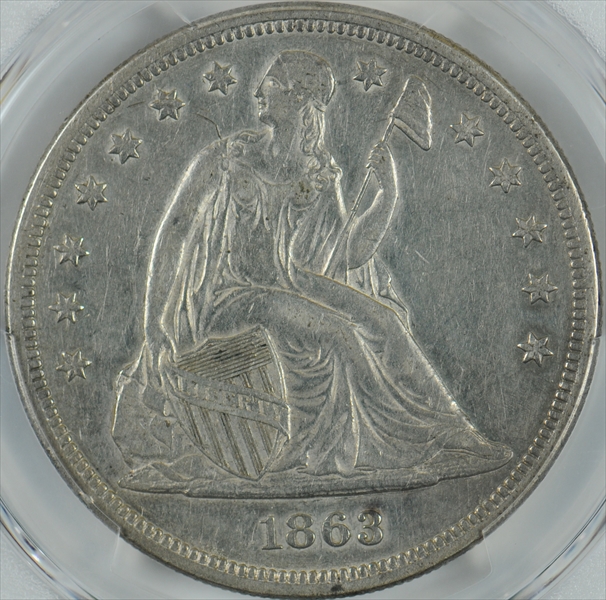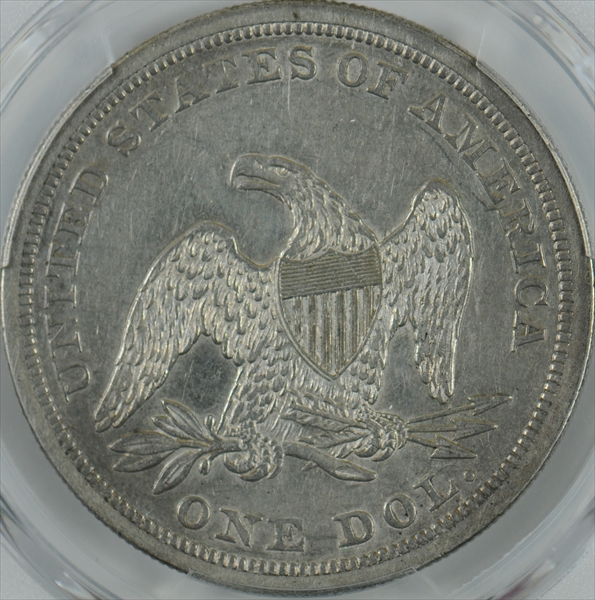1863 $1 XF45 认证号38795433, PCGS号6953
专家评论
Q. David Bowers
The following narrative, with minor editing, is from my "Silver Dollars & Trade Dollars of the United States: A Complete Encyclopedia" (Wolfeboro, NH: Bowers and Merena Galleries, Inc., 1993).Coinage Context
Coins exported: Walter H. Breen states that most Philadelphia Mint silver dollars 1862-1865 were "exported to Latin American and East Indian ports."!
It is certain that the Treasury paid none out at face value, for they were worth a premium and, further, specie payments were still in suspension. Such coins would have been available in exchange for bullion deposits, less a handling and coinage charge, and were eventually purchased at a premium by banks, bullion dealers, and others needing them for the export trade.
Because most Liberty Seated dollars were struck on private account and paid out to depositors of bullion, the mintage of a given issue would not have returned to a Treasury vault until some years later, if at all. The dispersal of such dollars at later times does not indicate how they were obtained in the first place. Records were not kept of such matters."
To suggest that most of the mintage of silver dollars remained in Treasury vaults awaiting the resumption of specie payments (which did not take place on a large scale until 1876) would not seem to be correct. Further, if this had been done, then thousands of coins would have circulated domestically after the mid-1870s, and circulation strikes in grades such as VF and EF would be much more available today than they actually are.
However, it is possible that the Treasury retained various quantities of certain issues. Apparently, there was no single hard and fast rule that applied to silver dollar distribution during this period.
Numismatic Information
Circulated grades: Circulated examples of 1863 have much the same story as 1862. Low mintage, export, etc., combined to make this a rare date in all circulation strike grades. The desirability of coins of this era, while long known to numismatists, has been accentuated by the activities and camaraderie among members of the Liberty Seated Collectors Club-which is great, for fellowship is one thing that coin collecting is all about.
As a class, circulation strikes (in all grades from well-worn to Mint State) appear in auctions far less often than do Proofs. This observation is not completely objective, for by far the largest number of circulated silver dollars that change hands numismatically do so by private sale, not by auction. On the other hand, I believe that a fairly large number of transactions involving Proofs are consummated via auctions.
Mint State grades: As might be expected from the production figure, Mint State examples of 1863 are rare today. However, enough survive that the patient numismatist can sooner or later acquire a top level example. In the meantime, he will have had the opportunity to consider several Proofs, for as a class these are more frequently encountered. High grade Mint State coins usually have heavy die striae evident, especially on the reverse.
Varieties
Circulation strikes:
1.Normal Date: Breen-5469. Obverse: Centered date. Circulation strikes are believed to have been struck from only one obverse die.
Dies prepared: Obverse: Unknown; Reverse: Unknown
Circulation strike mintage: 27,200; Delivery figures by day: March 9: 3,800; March 26: 1,400; April 10: 15,400; November 22: 6,600.
Estimated quantity melted: Unknown
Characteristics of striking: Most are well struck
Known hoards of Mint State coins: None
Commentary
In terms of specimens appearing on the market in auctions in recent years, Proofs outnumber circulation strikes by a considerable number.
Circulation strikes:
Enabling legislation: Act of January 18, 1837
Designer of obverse: Robert Ball Hughes (after Gobrecht)
Designer of reverse: Robert Ball Hughes (after Reich)
Weight and composition: 412.5 grains; .900 silver, .100 copper
Melt-down (silver value) in year minted: $1.040
Dies prepared: Obverse: Unknown; Reverse: Unknown
Circulation strike mintage: 27,200; Delivery figures by day: March 9: 3,800; March 26: 1,400; April 10: 15,400; November 22: 6,600.
Estimated quantity melted: Unknown
Characteristics of striking: Most are well struck
Known hoards of Mint State coins: None
Commentary
In terms of specimens appearing on the market in auctions in recent years, Proofs outnumber circulation strikes by a considerable number.
Additional Information
Notes Concerning 1863-1864 Pattern $1
The following notes are from two specimens in silver of the 1863 and 1864 "pattern" Liberty Seated dollars with IN GOD WE TRUST on the reverse, Judd-345 and J-396 respectively; specimens appearing in the Van Arsdall and Antelope Valley Collections Sale, Bowers and Merena, January 1993. These observations are to aid in further study of the pieces, the exact time of striking of which is not known, but is believed to have been later than the dates on the coins:
The reverse of the 1864 dollar is from an earlier state of reverse used to coin the 1863.
The 1864 has numerous raised die finish lines, including one extending from the base of the final A in AMERICA about 40% of the way toward the back of the top arrowhead; diagonal lines from the upper left corner of R and I to denticles, diagonal lines from right side of base of upright of R into field; line adjacent to right side of ribbon of first A in AMERICA downward passing close to the end of the ribbon, and curving to near the top of the eagle's left (observer's right) wing; nearly horizontal line over middle and right side of T of UNITED and all of E; microscopic line from left bottom of N to eagle's wing, then discontinuous, then continuing again immediately under the eagle's dexter (observer's left) wing (this is the sole die finish line that is visible also on the 1863); and numerous die lines beneath and near the bottom two arrowheads. The spaces within the shield stripes are only partially polished, with the most polish at the leftmost space. Additional shield stripes appear somewhat curved, rather than flat, and have not been fully polished.
The 1863 die, from a later state, is more highly polished, obliterating most of the die lines just mentioned, adding more Proof surface within the shield stripes (although the rightmost shield stripe opening is still not polished, and the shield stripes toward the right are not polished at the base), adding Proof finish between the topmost claw and the branch, and traces of Proof finish in the ribbon folds under ST of TRUST.
The 1863 obverse die has an unfinished area under Miss Liberty's chin, with no Proof surface at all. The area of non-Proof surface extends in a curved line from the front of her chin to her shoulder. A raised die finish line extends from Miss Liberty's rightmost (observer's right) bottom curl upward to slightly above where the liberty cap meets the pole, with the line being not quite parallel to the pole, but coming toward it. A microscopic die finish line connects stars 4 and 5 near the centers between the points. Around the date are numerous die finish lines, including some curving down to the right below and at the bottom right of the 3. The digits 1 and 3 are L2 mm. from the base of Liberty. On the flat surface of the lower right of the digit 8 there is a semi-circular raised die defect. The digit 6 has some raised lumps at its lower left and a small raised area at the upper right of the lower curved area. The digit 3 has a tiny raised defect at the upper right.
The 1864 date has a tiny rough area between the right base of Liberty and the denticle, and is not fully polished. The area beneath Miss Liberty's chin is largely unfinished, but the unfinished area begins slightly in from the bottom of the chin. The top of the 1 in the date is slightly under 1.1 mm. below the base of Miss Liberty. The top of the 4 in the date is just about 1 mm. below the base of Liberty. The digits in the date have slightly rough surfaces. At the upper right of the lower curve of the 6, close to the inside, there is a small raised lump. In the upright of the 4 there is a small raised lump, roughly triangular in appearance, near the upper left. About 40% of the way down the upright of the 4, on the left side, are two small raised lumps.
Questions posed are these: (1) On what other date(s) of pattern and regular issue dollars was this reverse die used? (2) Was the 1863 obverse ever used to strike regular Proofs of that year (without motto on reverse)? (3) Was the 1864 obverse ever used to strike regular Proofs of that year?
PCGS #
6953
设计师
Christian Gobrecht
边缘
Reeded
直径
38.10 毫米
重量
26.73 克
铸币数量
27200
金属成分
90% Silver, 10% Copper
更高评级数量
106
评级较低的钱币数量
81
地区
The United States of America
价格指南
PCGS 数量报告
拍卖 - PCGS 评级的
拍卖 - NGC 评级的
稀有性和存量估计 了解更多
| 所有评级 | 1100 |
| 60或以上 | 100 |
| 65或以上 | 7 |
| 所有评级 | R-4.9 |
| 60或以上 | R-8.0 |
| 65或以上 | R-9.6 |
| 所有评级 | 5 / 30 TIE |
| 60或以上 | 19 / 30 TIE |
| 65或以上 | 18 / 30 TIE |
| 所有评级 | 12 / 45 TIE |
| 60或以上 | 28 / 45 TIE |
| 65或以上 | 26 / 45 TIE |
























